- Exclusive
- National
- Roberts-Smith case
This was published 1 year ago
‘You machine-gunned that guy’: A witness tells his truth of day he will never forget
On a brisk spring morning in 2018, two special forces veterans of Australia’s war in Afghanistan entered a busy cafe in Canberra and, after pleasantries, began a grim-faced meeting. To the public servants sipping their coffees nearby, the pair would probably have stoked interest because of the identity of one of them.
At six foot six, and as wide as an English oak, Ben Roberts-Smith, VC, was hard to miss. On the morning in question – Friday, October 18 – Roberts-Smith was the most decorated Commonwealth veteran to have served in Afghanistan, an ex-soldier whose portrait hung in the nearby war memorial in testament to his status as the noble face of the Afghanistan conflict.
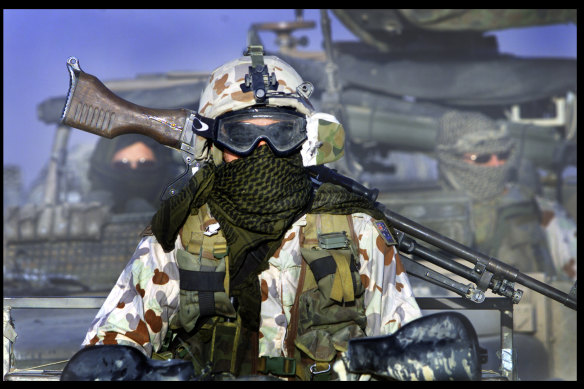
SAS soldiers on patrol in Afghanistan.Credit: Simon O’Dwyer
The war hero had also more recently intensified his very public campaign to clear his name of allegations detailed months earlier in this masthead. The stories raised the prospect that Australia’s most revered military figure was also its most notorious war criminal, and that oversight and ethics had collapsed in some pockets of the nation’s elite Special Air Service Regiment.
Roberts-Smith had hit back at the media reports by launching a public relations campaign and a defamation case backed by his employer, Seven West Media. On Thursday, that case comprehensively failed, with Federal Court judge Anthony Besanko ruling that Roberts-Smith had murdered unarmed Afghan prisoners and was a war criminal.
The meeting at the Muse cafe was part of a clandestine operation being conducted by Roberts-Smith to try to prevent that truth coming out. It was aimed at ensuring none of his SAS comrades turned against him. Its genesis was a mission 10 years before, in a much more dangerous place.
Is today the day?
Was today the day he was going to die? Crack-thump. Dean Tilley* breathed in sharply as a bullet thudded into the ground a few metres away. Crack-thump.
Another round hit closer and his body tensed further. The SAS scout had woken with the breaking Afghan dawn a few hours earlier. He had splashed his face with cold water and started preparing for an uneventful trip back to base.
His SAS troop of a few dozen men had spent the night – the eve of Easter Sunday 2009 – on a dry, rocky outcrop near Kakarak, a typical Afghan village, with mud-walled compounds ringed by large fields of verdant crops.
Crack-thump. Another round whizzed by. The insurgents firing at the SAS knew what they were doing, thought Tilley. They were clearly battle-hardened, bold and well armed.
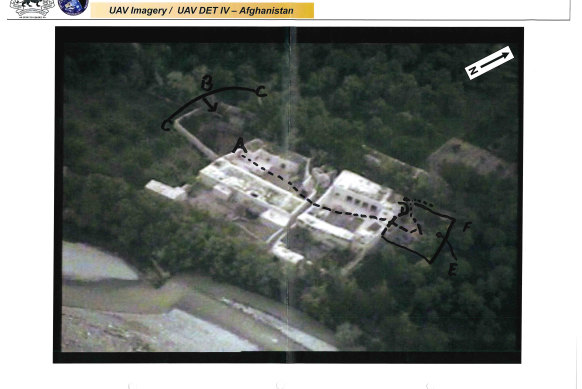
An aerial photo of Whiskey 108 marked up in court by Ben Roberts-Smith during his Federal Court defamation case.
As the Australians readied to confront them, Tilley perched on the edge of the outcrop in a sniper position, scanning the crops and compounds for men who appeared and vanished like startled ghosts.
Coalition aircraft circled in the sky above. The SAS had been ordered to raid a likely insurgent stronghold they had named compound Whiskey 108, but one of the birds would drop their payload on this target first, a massive bomb obliterating part of the mud-walled structure in a cloud of dust, fire and smoke.
It wasn’t until the light began to fade that Tilley and his fellow SAS soldiers advanced towards the damaged Taliban hideout.
By then, the weather had closed in and the sky was a patchwork of greys, growing darker in the drizzle.
Tilley’s six-man patrol was responsible for finding the stealthiest path to lead the other small teams of SAS fighters towards the hidden enemy.
As the scout of his patrol, Tilley would be the first man forward: the tip of the spear.
It was a job the pugnacious soldier with a broad, boyish face relished. He was built like a classic old-school SAS operator: six foot and with a physical presence that belied his lithe build and mischievous grin.
Tilley strode towards the insurgent hideout, his mind willing his body towards an enemy he had assessed not just as formidable, but willing to die for their cause.
He felt a pang of fatalism, a sensation he’d felt on previous missions but which he’d usually been able to quickly counter by telling himself: not today.
This was different. It felt sharper, more vivid. Today, Tilley found himself thinking, may well be the day ...
Before he could further analyse this black thought, he glimpsed an aqueduct splitting the earth between him and the target compounds ahead.
Now, he was focused solely on gaining the speed to make it across the lengths of rotting wood the locals had placed over the water and mud below.
He leapt, one foot racing after the other, until he felt the relief of hard ground.
Glimpsing behind, he watched patrol members follow his path and bolt across the makeshift bridge, then trained his eyes forward and strode into a poppy field.
The poppies stood tall and strong. A few metres in, Tilley realised they were also wet, a sea of upright red-tongued snakes surrounding him, soaking his uniform.
Blocking out any discomfort, he moved on to a nearby mud-walled alleyway system by the poppy field. He heard a sound and froze. The creak of a door.
Was this the moment? Tilley was already on one knee, rifle raised towards the opening door, his finger ready to squeeze.
His eyes were focused ahead, but he sensed his comrades behind him halting, a backwards baton relay of danger and unease.
The door opened wider and an Afghan walked out. Every cell in Tilley’s body was trained on the Afghan, but the man didn’t notice the Australian soldier or the gun pointed at him.
Tilley counted the seconds – 10 ... 20 ... 30 ... – as the Afghan walked away from him and into the poppy field, oblivious to the shadow of death stalking him.
Only then did Tilley relax his trigger finger, draw breath, stand up and stride onwards.
The poppy field, sodden ground and drizzle, mirrored the jungle reconnaissance training Tilley had undergone years before.
This was textbook SAS operating environment for the camouflaged line of advancing soldiers, thought Tilley, as he dipped into the aqueduct.
This thought didn’t last, as the sound of two shots fired from the rifle of one of his patrol members rang out.
Tilley felt a fresh rush of adrenalin. With his view obscured by the aqueduct walls, he raced up the mud embankment to find his patrol commander training his weapon in the direction of a dense clump of twisted trees.
Before Tilley could settle his breathing, machinegun fire exploded and he plunged forward into the mud and grass, waiting for the pain.
But there was no heat, no blood, so he popped his head up and looked behind him.
“OK … that is our gun,” he said to himself as he got back to his feet and continued closing in on the suspected enemy stronghold.
A few feet out, he dropped again to his knee and scanned the compound walls for any openings offering a glimpse inside.
It was then that he noticed the very top of a man’s head. It was bobbing above the wall towards a large gap that would soon bring its owner into complete view.
He appeared to be carrying something. If the man exited and turned towards Tilley, he would see the Australians and possibly engage them.
If he moved the opposite way, Tilley could avoid taking his life.
“Don’t f---ing turn our way,” Tilley whispered to himself, heart racing. “Don’t …”
It was too late. His finger squeezed the trigger and the man fell. Tilley felt his heart pounding as he waited for the body to move, but it lay still. (During a later search of the Afghan, it was found he was carrying a mobile phone, indicating his status as an insurgent.)
Tilley calmed himself, taking up a cordon position outside Whiskey 108 as his SAS comrades moved in, guns raised.
He watched them silently advancing, and wondered what was waiting for them inside.
Minutes ticked by as Tilley scanned the compound perimeter, looking for any sign of an attack from insurgents hiding in the surrounding fields.
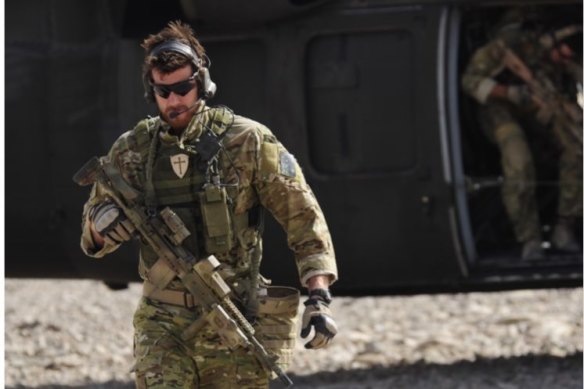
Ben Roberts-Smith in Afghanistan.
There was stillness. As the sky darkened, Tilley’s attention was drawn to three Australian soldiers.
The trio were part of the assault teams that had entered Whiskey 108. For some reason, they had walked a few feet outside one of the compound walls.
As Tilley turned to observe them more clearly, he saw a dark mass being thrown on the ground by the largest of the three Australians.
As the shape hit the ground, it made a sound. It was a man exhaling, as if badly winded.
That was followed quickly by another much louder sound. Tilley recognised it instantly. The burst of an Australian F89 Minimi machinegun firing.
Before the man could rise, the soldier who had tossed him into the mud had fired into his body. Now it was Tilley who felt winded.
“What the hell?” he said to himself.
The man had been tossed by the large Australian soldier like a rubbish bag, only to have his body ripped apart by bullets.
The soldier who had fired was wearing distinctive camouflage paint and was unmistakably large, strong enough to handle a machinegun with one hand.
But it was too dark for Tilley to make out his face. He turned to another soldier within earshot.
“What the hell?” he hissed.
He walked over to the man who had been machine-gunned. Lying on his back was an unarmed Afghan with a short, dark beard, flowing robes and a white prosthetic leg.
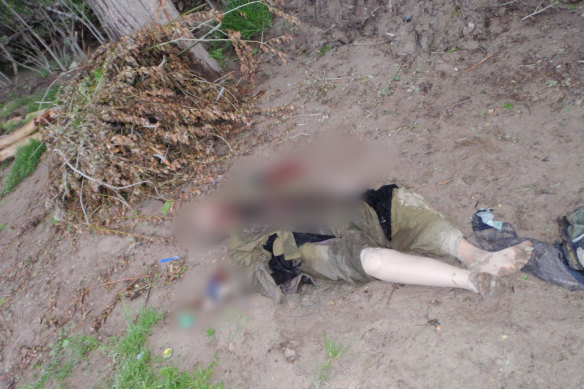
The man with a prosthetic leg who was killed in 2009. We have chosen to blur the image.
The man’s bloody, empty face confirmed what Tilley already suspected. He was dead.
“What the hell?”
The question would stay with Tilley for weeks, and then months, and then years.
As time went by, new snippets of information emerged at SAS headquarters, including a claim that the dead man with the plastic leg was actually an armed insurgent who had been shot as he’d brazenly raced towards an SAS soldier.
That this story was being peddled as truth served only to underline the question he had asked when the Minimi first erupted.
“What the hell?”
Not just a friendly chat
Not quite a decade later, on October 19, 2018, Tilley sat in the cafe of the East Hotel in Canberra, waiting for the most famous alumni of his regiment to appear.
The meeting had been arranged as a friendly catch‑up. The timing suggested otherwise.
Everyone in the SAS knew that Roberts-Smith was rallying his supporters, having sued the newspapers that had written about him, alleging his involvement in war crimes, including two executions on the Easter Sunday mission back in 2009.
Days earlier, Tilley heard from Roberts-Smith via an encrypted application. His message was anodyne, flagging that Roberts-Smith would be in Canberra, suggesting a coffee.
Tilley had responded and they arranged to meet.
“No problem,” he’d texted.
The SAS soldier’s guard was up, though. Unlike others in the SAS, Tilley had received no defamation threats from Roberts-Smith’s lawyers, but he was mates with those who had.
He was also one of the two dozen or so witnesses the media outlets wanted to subpoena because they had been on the Easter Sunday mission.
Tilley was like most of these soldiers.
He didn’t want to testify for the media, nor did he want to jump in the box for Roberts-Smith. He wanted nothing to do with the case at all.
Roberts-Smith was taking no chances. That morning, he had given an interview to the Murdoch-owned Sky News channel in which he’d sharply criticised the newspaper reporters who had implicated him in war crimes and whom he was suing.
Their claims were “completely untrue”, Roberts-Smith had told Sky News.
In the interview, Roberts-Smith had also savaged the truth defence the newspapers’ lawyers had just filed in the Federal Court: “We are talking about scenarios of battle that have been twisted and, in many cases, falsified to resemble the allegations that Fairfax are reporting.”
The filing of the truth defence was what had prompted him to reach out to Tilley.
The lawyers had indicated to the court that they intended to call multiple witnesses to testify about executions committed on Easter Sunday 2009. One of them was Tilley.
Roberts-Smith wanted to test the loyalty of his old comrade. While the documents filed with the court by the newspapers indicated whom the newspapers wished to call as witnesses, they gave no indication about whether they were actually co-operating.
That could explain why Roberts-Smith confidently told Sky News he would be vindicated.
Even so, Roberts-Smith needed to know for sure that Tilley would be on team BRS. When Tilley spotted the large soldier, he rose from his seat and extended his hand.
“How’re you going?”
The men greeted each other with a strained casualness that continued through a few minutes of small talk. It vanished, overtaken by a frosty formality, when Roberts-Smith brought up the purpose of the meeting.
He pulled out a copy of the newspapers’ truth defence like a prosecutor brandishing a murder weapon before a jury.
Tilley had never seen the file before. “I’m not signing anything mate,” he said, momentarily confused.
“I’m not trying to get you to sign anything. I want you to read it. I know it’s not … I know it’s not you,” Roberts-Smith said, before adding: “I know we will be all good.”
Tilley didn’t respond, but began scanning the document.
The journalists’ lawyers had placed him as one of a few soldiers with a clear line of sight to the execution of an Afghan prisoner outside compound Whiskey 108 on Easter Sunday, 2009.
Someone close to Tilley must have spoken to them. Tilley glanced up at Roberts-Smith and looked him square in the eyes.
“Well … actually … that’s how I remember it … You were pretty loose at Whiskey 108. You did a lot of things in front of the young guys you shouldn’t have.”
Roberts-Smith appeared shocked.
“You can’t get in trouble for perjury if you legitimately don’t remember,” he told Tilley.
Tilley was resolute in his response. If he was subpoenaed to the Federal Court or to the Brereton inquiry into war crimes in Afghanistan, he would be telling the truth.
“I’m not going to lie on the stand. The truth is the only thing that will protect me.”
The large ex-soldier then changed tack. Tilley couldn’t be a witness to something he hadn’t actually seen.
“Your patrol was on the other side of the compound,” Roberts-Smith said.
But Tilley was in no doubt where he was located on Easter Sunday. He remembered the drizzle in the air, the thickness of the poppy crop that had swallowed him up as he waded through, and the mud and grass he’d dived into when a burst of gunfire exploded near him.
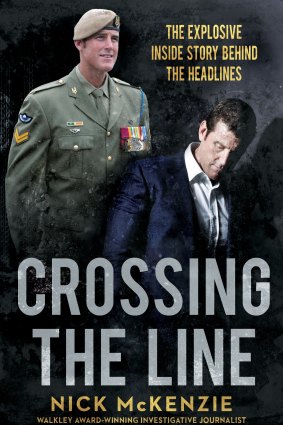
McKenzie’s new book will be published in July.
The whole mission was seared into his brain because he had expected he was going to be killed and, instead, had taken a life.
An Afghan had popped out from a wall and, believing he posed a risk to the Australian soldiers creeping up on Whiskey 108, Tilley had shot him.
Tilley also remembered clearly what happened after this, in the fading light.
A large soldier with paint on his face who was holding a machinegun had stepped outside the compound walls and thrown a large dark mass to the ground.
Tilley later discovered it was an Afghan man with a prosthetic leg.
Across the cafe table, Tilley held Roberts-Smith’s gaze again.
“Come on, mate … You machine-gunned that guy,” he said to him. “Ben, there’s no way I am going to get up on a stand and lie. And I hope no one else does.”
Tilley watched his old comrade as silence descended over the table. Roberts-Smith turned to look outside the cafe window. He appeared lost in his own thoughts.
Thirty seconds passed until Roberts-Smith turned back to face him. “I don’t even know what to say,” Roberts-Smith said stonily.
Tilley responded by rising from his chair: “Thanks for the coffee.”
He then turned and walked away.
In the end the judge preferred Tilley’s version of events of what happened at Whiskey 108 over Roberts-Smith’s lies.
- This story is sourced from testimony given in court by SAS soldiers. *For legal reasons, the name Dean Tilley is a pseudonym.
- Crossing the Line by Nick McKenzie will be published in July, to pre-order click here.